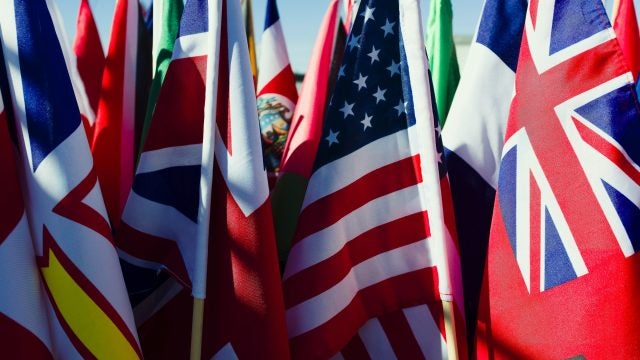
Title: Decoding Sino-American Relations Through A Dualist Account of Threat Perception
Recent trends in Sino-American relations can be explained through the framework of threat perception. However, we should view threat perception through a hybrid of rationalist and non-rationalist components to explain the deteriorating bilateral trust. Such an analytical treatment would in turn enable us to identify and pursue a range of constructive solutions to address Sino-American distrust.
China and the United States have an increasingly hostile relationship. The recent Chinese balloon shoot-down is one of the many examples of strained US perceptions of the world’s second-largest economy. Such resentments are matched in China, where nationalistic online communities circulate ideas that a declining United States would not tolerate an ascendant China thwarting US hegemony.
Quantitative and Statistical Evidence on Shifting Perceptions
Mutual threat perception—a shared viewpoint that the other state threatens one’s national interests—has largely increased between the two countries since the start of Donald J. Trump’s presidency in January 2017.
A 2016 Gallup survey indicated that 12 percent of surveyed Americans viewed China as the United States’ greatest enemy. By 2023, this number surged to 50 percent, an over-fourfold increase. Americans viewed China’s economic and military power to be highly likely candidates for possible threats to the vital interests of the United States.
More generally, a 2021 Pew Research survey found that 89 percent of American adults saw China as a “competitor or enemy” of the United States. These individuals might not perceive China to be the primary rival or opponent to the country—for some of them, at least, Russia may be the greatest cause for concern; yet such survey results offer us glimpses into the antagonism towards China that permeates the American public.
Similarly, a 2021 Carter Center report revealed that approximately 62 percent of China’s internet-using population held negative views towards the United States. This is slightly more positive than the American attitudes towards China; however, the results may be skewed, as individuals who use the internet frequently in China may have more cosmopolitan world views and, consequently, be more tolerant of the United States.
Respective governments have also hardened policies and rhetoric against the other over the past six years. Throughout Trump’s tenure and into the Biden administration, we’ve seen mutual expulsion of journalists, heated disputes over the origins of COVID-19, and heightened concerns over Chinese technology firms, contributing to deteriorating bilateral relations.
Establishing the Theoretical Proposition—A Diagnosis
Existing literature approaches the issue of threat perception through bifurcated lenses. The first cluster of frameworks constitutes what I term the rationalist view, which holds that country A views country B as a threat, on the grounds that B possesses capacities that threaten A’s fundamental security or core interests, in economic, military, and political terms. The second cluster comprises the non-rationalist view, which means that A perceives B as a threat due to (but not limited to) ideological differences or personal relationship breakdowns between senior politicians, an ultimately emotive response.
There has, nevertheless, been a nascent shift over the past decade that acknowledges the two views as complimentary: the two sides of the same coin. Similar to both Janice Stein and May Darwich, I suggest that we adopt a dualist account of threat perception—one that recognizes both rationalist and non-rationalist forces. The two dimensions are conjoined at their hip through how decision-makers perceive threats or challenges to their symbolic-normative interests—interests that help governments maintain symbolic supremacy and legitimacy.
Empirical evidence also supports this dualist approach. The rationalist view struggles to justify the perceptions of a serious Chinese military threat. In terms of overseas military bases, the United States has over 700, while China only has one. This illustrates how China lacks the capacity to sustainably project its military presence on a global scale. While Beijing appears to be advancing its surveillance sophistication and frequency, the PRC is yet to challenge the United States’ long-standing advantages in information technology and strategic partnerships with countries with highly established intelligence infrastructures, such as the Five Eyes. Similarly, a wholly non-rationalist view framing the animosity between US and Chinese publics as pure projections of long-standing mistrust, resentment, and grievances does not hold water. It strains to explain why mutual animosity has surged considerably since the early 2010s, especially after a decade of broadly amicable relations between the late 1990s and the early 2010s. Ultimately, we must look at both types of threat perception to fully comprehend the driving factors of Sino-American animosity.
How Can the United States and China Tackle the Mutual Threat Perception?
What can be done in face of the prevalent mistrust between Beijing and Washington? The above has demonstrated that threat perception leans heavily into certain claims that are, in economist Stephen Roach’s words, “false narratives.”
Firstly, both countries need to establish resolutions and engagement policies, especially in the presence of their dueling motivations, whether that be competition for economic or strategic influence. Indeed, past relationships between the two governments illustrate a possibility for close bilateral ties. For example, there has been long-standing personal connections between former Chinese Foreign Minister Yang Jiechi and the Bush family. The sea change in PRC leadership and personnel at the past Party Congress and Two Sessions presents an opportunity to reconstruct diplomatic backchannels and relationship-driven communications, which would significantly ameliorate non-rationalist threat perceptions.
On a more rationalist level, dialogue should increase, not just on mutually beneficial topics such as public health and climate change, but also on areas where the two countries have radically divergent positions, including the South China Sea, cross-Strait relations, and Sino-American technological competition. By emphasizing the commonalities between the two states, the United States and China can draw closer their “compromise” position—whilst keeping intact fundamental “baselines”—and develop joint research initiatives to generate a stable world order. On the other hand, by exposing and discussing at length areas of potential and actual conflict, Beijing and Washington can hopefully cultivate the prerequisite for guard railing against spillovers and escalations.
In addition, mass threat perceptions are somewhat rooted in reactions to anticipated impediments to self-interests. Such perceptions may not affect military strategic planning, yet they remain pertinent when it comes to business or consumer decisions. Reducing the level of mistrust—which cuts across both rationalist and non-rationalist components of threat perceptions—requires humanization and clarification of the heterogeneities in the respective countries. Both the United States and China will benefit from serious reflection on how the other country has been portrayed in their media. Despite allegations of the so-called “Western media bias” in ultra-nationalistic Chinese criticisms, partisan and politically explicit (though not necessarily biased) reporting is by no means a “West-only” phenomenon.
On the front of rebuilding the frayed relations, it falls upon the Chinese state, with its extensive control and influence over state-affiliated media, to realize that talking up both the threat and purported decline of the United States would only bolster unconducive antagonism towards Washington that further constricts its policy options. Civil society discourse in China remains heavily intertwined with official narratives, and thus any argument concerning transforming public discourse and perceptions of the United States must begin with the government.
This is not to say that Beijing does not take into account opinions from respected members of the academe and think tanks in the country. Certain experts and analysts in China are understandably aggrieved by what they perceive to be distortionary reporting on China. Yet, the best means to counter such coverage is through open, unfettered debate. The Chinese state does have the capacity to pursue a more even-handed and nuanced approach to shaping public discourse; throughout the late 2000s and the early 2010s, it sought to rein in domestic nationalist outbursts and to steer popular discourse so that the country would become more welcoming for foreign investment. The rhetorical framing of the other side being a “threat” limits interaction between the two countries in the private sector and comes at the active detriment of ordinary civilians that straddle the Pacific divide.
Finally, it is apparent that the United States and China have a deficit in knowledge and real expertise concerning the “other” in popular discourse. It is high time for the West to invest in cultivating greater understanding of and exposure to China, linguistically, historically, and socioeconomically, as opposed to leaning into an unidimensional unhelpful essentialist imagery. Amidst the surge in racially motivated violence targeting ethnic Chinese communities in the West, it is vital to ensure that their rights and welfare are protected. Indeed, it is critical that the United States empowers and takes seriously the ability of individuals who are willing to play the role of bridges and interlocutors with the other side of the Pacific.
There is no shortage of high-net-worth investors and businessmen, respected intellectuals, and veteran journalists who have long straddled the Pacific and advised policymakers on both ends. Organizations such as the Committee of 100, US-China Business Council, the American Chamber of Commerce in mainland China and in Hong Kong, the Better Hong Kong Foundation, and think tanks such as the Carter Center and Carnegie-Tsinghua Center for Global Policy have long served as bridgeheads for discourse and mutual understanding between the two countries.
There is space for these individuals to step out and speak up today. They have been squeezed by the increasing securitization of the bilateral relationship and refrained from honest and dynamic engagement with one another. With both Chinese and US political establishments turning considerably towards framing pro-engagement individuals and groups as partaking in ostensible “influence operations” or cooptation efforts, engaging with “the other” has become a risky undertaking. More fundamentally, it remains unclear how such interlocutors can play a concrete role in influencing policymaking on a governmental level given the mainstream discourses in the two countries. Despite all the talk of track-II diplomacy, as I have written elsewhere, there can be no diplomatic efforts led by the civil society without receptiveness from their respective governments.
Conclusion
The perceived threats between Beijing and Washington and between the Chinese and US populations are multi-faceted and intertwined. The prognosis for Sino-American relations remains grim. The “uneasy peace” between the two leading powers established at the Biden-Xi summit in Bali can easily be ruptured, as evidenced by recent events. We can only hope that strong and pragmatic leadership will emerge from both sides to act in concerted manner to contain and reduce the salient threat perceptions.
Doing so requires politicians and statesmen to take seriously not just the military or economic dimensions, but also the symbolic-normative dimension of threat. Tackling the multiple aspects of threat perception requires the development of realistic rules of engagement strengthened through interpersonal ties. These can be materialized through the establishment of joint positions and task forces between Beijing and Washington and active efforts taken to recalibrate the portrait of “the other side” through popular media. Above all, the two governments need to first express their shift in attitude before the civil societies can use their influence to implement positive changes.
. . .
Brian Wong is a Rhodes Scholar from Hong Kong (2020), political theorist, and third-year PhD candidate in Politics at Balliol College, Oxford. He has taught undergraduate students at both Oxford and Stanford Universities. Brian is a prolific writer and strategic advisor on Chinese foreign policy and politics, contributing regularly to publications such as Nikkei, The Diplomat, TIME, Foreign Policy, E-IR, and the Institute of Art and Ideas.
Image Credits: Defense Visual Information Distribution Service
Recommended Articles

On May 20, 2025, the World Health Assembly unanimously adopted the World Health Organization (WHO) Pandemic Agreement, an international treaty designed to strengthen pandemic prevention, preparedness, and…

As the Trump administration proposes a sweeping overhaul of the US foreign assistance architecture by dismantling USAID, the Millennium Challenge Corporation (MCC), and restructuring the State Department, there is an…

The Trump administration’s abandonment of allies and embrace of Putin’s Russia has raised pressing questions about whether Estonia, Latvia, and Lithuania can continue to rely on NATO for…